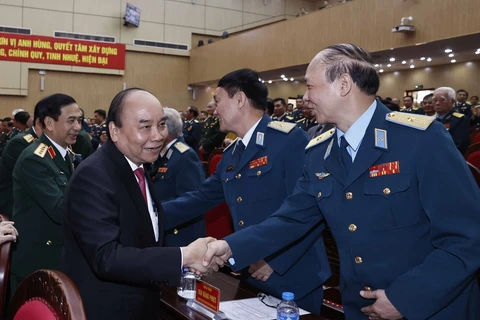 The exhibition showcases many important artifacts related to the Paris Conference (Photo: VietnamPlus)
The exhibition showcases many important artifacts related to the Paris Conference (Photo: VietnamPlus) Hanoi (VNA) - More than 200 documents, photos and objects featuring negotiations for the signing of The Paris Agreement on Ending the War and Restoring Peace in Vietnam (Paris Peace Accords) 50 years ago are on display at an exhibition in Hanoi.
The exhibition, opened on January 5, was held by National Archives Centre III under the Ministry of Home Affairs' State Records and Archives Department.
The exhibits are being preserved at National Archives Centres II and III, the archives of the Foreign Ministry, the Vietnam National Museum of History, and the national archives of the US and Russia. Also present at the event were representatives of the liaison board of war veterans who once served in the Joint Military Group at Davis Camp, and some witnesses of the negotiations.
The Paris negotiations lasted for nearly five years, with bilateral talks from May 13 to October 31, 1968, and four-party talks from January 25, 1969 to January 1973.
During bilateral talks, the Democratic Republic of Vietnam demanded the US to cease the war by October 31, 1968, and accept the convening of a four-party conference with the participation of the National Front for the Liberation of South Vietnam.
In the four-party negotiations, the Democratic Republic of Vietnam and the Provisional Revolutionary Government of the Republic of South Vietnam steadfastly ordered the US to end the war, withdraw its troops from Vietnam, and respect the right to self-determination of the people in the South.
After 201 open sessions, 45 high-level private talks, 24 secret meetings, 500 press conferences, 1,000 interviews, and hundreds of get-togethers in support of Vietnam, the Paris Agreement was signed on January 27, 1973, by the Democratic Republic of Vietnam, the National Front for the Liberation of South Vietnam, the Republic of Vietnam, and the US.
Consisting of nine chapters with 23 articles, its main content was that the US and other countries pledge to respect independence, unity, sovereignty, and territorial integrity of Vietnam. The US would completely end its invasion war, military engagement, and interference in the internal affairs of South Vietnam while respecting the right to self-determination and guaranteeing the rights to freedom and democracy of the people in South Vietnam.
The agreement put an end to the longest and most difficult struggle in the history of Vietnam's diplomacy.
 Head of Davis Camp Liaison Board Senior Colonel Dao Chi Cong visits the exhibition (Photo: VietnamPlus)
Head of Davis Camp Liaison Board Senior Colonel Dao Chi Cong visits the exhibition (Photo: VietnamPlus) According to Foreign Minister Bui Thanh Son, the Paris Peace Accord is vivid historical proof of the aspiration for peace and the tradition of amicable diplomacy of the Vietnamese people. The accord is also an important premise of the foreign policy of independence, self-reliance, multilateralisation and diversification in the period of Doi Moi (Renewal) and extensive international integration over the past more than 35 years.
Under the sound and ingenious leadership of the Party Central Committee and President Ho Chi Minh, the agreement created a turning point in the situation and the balance of power which was beneficial for the Vietnamese revolution, towards the complete reunification of the country in 1975, Son said.
In his opening remarks, Deputy Minister of Home Affairs Nguyen Duy Thang said that the exhibition is of historical and cultural significance. He said it has given historians and diplomats as well as the public great insight into the Paris Conference, honoured the Party's leadership, and promoted the glorious traditions of the nation.
The exhibition provided an overview of the domestic and international context leading up to the Paris Conference.
At the exhibition, historical witnesses who directly contributed to the success of the Paris Conference shared their own stories./.

























